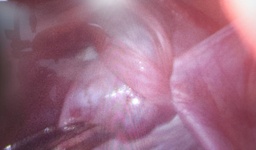“Don’t miss the twist
Untwist the twist”
Introduction
Adnexal torsion is a common gynaecologic surgical emergency which needs prompt diagnosis though challenging based on clinical symptoms and imaging techniques (Doppler USG and MRI), it also warrants timely surgical intervention to preserve ovarian function and future fertility. We present the case report of ovarian cyst torsion in an adolescent were early diagnosis and immediate surgical intervention had saved the adnexa from irreversible damage preserving her ovarian function and future fertility.
CASE REPORT
A 17 year old girl had reported to emergency room with complaints of sudden onset of severe lower abdominal pain which was continuous for few hours and settled with analgesics, she had another episode of severe lower abdominal pain after 4 hrs which was associated with vomiting.
She had attained menarche at 12 yrs of age and had regular cycles 3/30 days, normal flow, not associated with dysmenorrhea.
On examination:- Patient was anxious, conscious and oriented, her vitals were (BP – 90/60 mm Hg, PR – 87 / min, SPO2 – 99%, Temp – 98.4°F) Per abdomen – Soft, severe tenderness in hypogastric region.
Laboratory investigations:
Hb – 11.1 gm/dl, PCV – 33.8, TC – 8000, DC-N76 L16
Ca-125-5.3 u/ml, BhCG – < 2.30 miu/ml, alpha fetoprotein – 2.1 ng/ml CEA < 1.73 ng/ml
Imaging:
USG Abdomen with Doppler –> Enlarged right ovary due to large tense cyst 6.3 x 5.5 cm with subtle echogenic contents within, vascularity seen in right ovary, possible torsion, mild fluid in pouch of douglas.

CT whole abdomen ® large fluid density lesion arising from right ovary around 7 x 6.3 cm likely to represent benign cystic lesion to rule out ovarian torsion
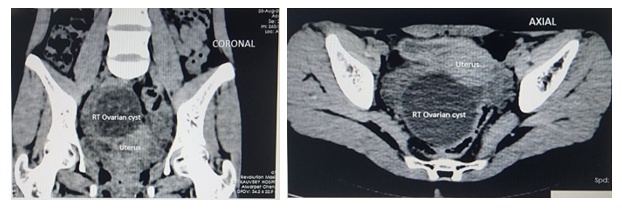
Management
| Clinical diagnosis
|
Right ovarian cyst with torsion based on symptoms of severe lower abdominal pain and vomiting |
| Supportive investigation | USG Doppler |
| Pre op counselling | Patient and parents were counselled for emergency laparoscopy to rule out torsion of adnexa, if the same found to proceed with detorsion and ovarian cystectomy, they were also counselled for right Salpingo oophorectomy if the adnexa (tube & ovary) was necrosed even after detorsion. |
| Consent | Obtained from parents |
| Surgery performed
|
Emergency laparoscopy Detorsion Right ovarian Cystectomy Right ovary preserved |
Intra OP findings
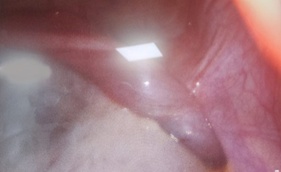 |
Around 7 x 8 cm right ovarian cyst with torsion of
pedicle twice |
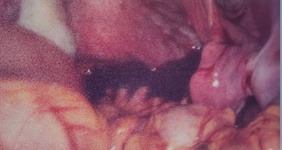 |
Minimal blood stained fluid in pouch of Douglas
around 50ml |
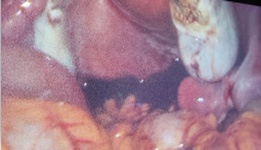 |
Detorsion of right ovary done
Cyst separated from ovary |
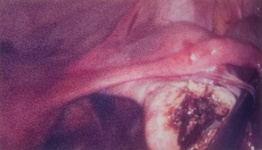 |
Preserved right ovary after ovarian cystectomy |
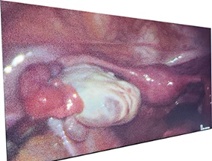 |
Cyst removed through port intoto.
Left tube and ovary normal |
Postoperatively patient recovered well and was discharged on 2nd post-operative day. Her histopathology showed benign serous cystadenoma. She was advised to follow up after 1 week.
Discussion
Adolescence is a period in life in which significant anatomical and physiological change occur and the girl child matures in to adulthood (10-19 yrs).
Incidence
In adolescence ovarian tumors account to 1-1.6 percent of neoplasia in children, majority of them are benign, 0.2% are malignant.
Incidence of torsion
In contrast to adnexal torsion in adults, adnexal torsion in paediatric and adolescent females involves an ovary without any adnexal pathology in 46% of cases. 30-40% of ovarian tumors are associated with torsion.
Ovarian torsion
It is a process that occurs when the ovary twists over the ligaments (infundibulo pelvic and utero ovarian) that support it in the adnexa, when the fallopian tube twists along with the ovary it is referred as adnexal torsion.
Most common ovarian pathology
All ovarian cyst have the potential to twist on their axis or torse occluding vascular supply, the risk of torsion increases when the size of the cyst exceeds 5 cm.
Benign functional cyst and benign teratomas are the most common ovarian pathology that undergoes torsion due to greater degree of mobility. 64% of torsion occurs on right side of ovary.
Pathophysiology
The ovary has dual blood supply from the ovarian arteries and uterine arteries, when the ovary twists over the infundibulopelvic and utero ovarian ligament, which causes swelling, obstruction of blood flow. Initially venous out flow is obstructed followed by arterial inflow leading to necrosis of ovary, infarction, haemorrhage.
Most common clinical symptom
Sudden onset of abdominal pain that is intermittent, non-radiating, associated with nausea and vomiting.
Evaluation
Ovarian torsion is a surgical emergency as the ovary must be promptly untwisted to restore perfusion and preserve ovarian tissue.
There are no clinical or imaging criteria sufficient to confirm the pre op diagnosis of adnexal torsion.
Laboratory tests should include complete haemogram to see for anaemia or leukocytosis. Tumor markers Ca-125, BhCG and α fetoprotein to be evaluated.
Imaging
Ultrasonography is considered gold standard for assessment of ovarian cyst, Doppler can identify the lack of blood flow to the ovary, trans-abdominal USG is the imaging modality of choice, when it is limited MRI is a valuable tool.
USG findings suggestive of ovarian torsion
- Unilateral ovarian enlargement
- Ovarian edema
- Hyper-echogenic ovary
- Peripherally displaced follicles
- Echogenic Stroma
- Free fluid in pelvis
- Coiled vascular pedicle (whirlpool sign which is highly specific but technically difficult to visualise).
- Doppler flow is preserved in 60% of cases due to intermittent torsion and collateral blood supply.
DOPPLER FLOW ALONE SHOULD NOT GUIDE CLINICAL DECISION MAKING
MRI Findings
Decreased ovarian enhancement, presence of multiple small peripherally located follicles, asymmetric ovarian enlargement, pelvic free fluid
CT findings
Asymmetric ovarian enlargement, fat stranding adjacent to ovary, pelvic free fluid, uterine deviation toward pathologic side.
Composite index
To reduce the number of negative laproscopies Composite index have been developed to better identify torsion before surgery. It comprises the following (clinical and radiologic predictors like vomiting, adnexal volume, adnexal volume ratio.
|
Adnexal volume ratio |
= |
Volume of affected ovary |
| ——————————–
Volume of unaffected ovary) |
into a composite score that accurately predicts torsion. Further studies are needed to validate these scores.
Management
Adnexal torsion is a surgical diagnosis.
Pre op counselling to be given to the patient and parents regarding:-
- Possibility of negative laparoscopy
- Risk of recurrent ovarian cyst and torsion
- 2 stage procedure if the underlying cyst was not removed.
- Possibility of underlying malignancy
Goals of Surgery
1) To detorse or untwist the adnexa and preserve the ovary regardless of the timing of presentation or its appearance. DETORSION IS THE STANDARD TREATMENT PROVIDED TO ADOLESCENTS WITH ADNEXAL TORSION
2) It is a myth that embolic phenomenon will occur after untwisting, there is no evidence to support venous thromboembolism
3) It is reasonable to proceed with concomitant ovarian cystectomy if cyst identified.
4) If friable ovary, causing additional trauma, incision and drainage and follow up for imaging should be advised after 12 weeks.
5) Oophoropexy is controversial and current data are in sufficient
6) Studies have shown that after detorsion of blue or black ovary, 2nd look laparoscopy after 36 hrs showed near normal appearing ovary
7) If irreversible damage has occurred to the adnexal structures then salpingo oophorectomy is performed in unavoidable situation.
Conclusion
Adnexal torsion in adolescents is a gynaecological cause of acute abdomen, clinical judgement is considered superior to other diagnostic approaches. Immediate surgical intervention is required to save the adnexa. Detorsion is the treatment of choice wherever possible with increasing stress over preservation of ovarian function and future fertility.
References
- Adnexal torsion in Adolescents: ACOG Committee Opinion No, 783. Obstet Gynecol. 2019 Aug; 134(2):e56-e63.
- SS Ratnam, K Bhaskar Rao, S.Arulkumaran Obstetrics and Gynaecology. 2006.
 Dr. Sabeeha T.S.
Dr. Sabeeha T.S.
Consultant Obstetrics and Gynaecology
Kauvery Hospital
Supporting medical team
ER physician – Dr. Vidya Saketharaman
Radiologist – Dr. Ramesh, Dr. Krishna Karthik
Anaesthetist – Dr. Hema I.
Surgical Oncologist – Dr. Sujay Susikar
Sr. Registrar Obstetrics and Gynaecology – Dr. Diksha Agarwala
Kauvery Staffs
